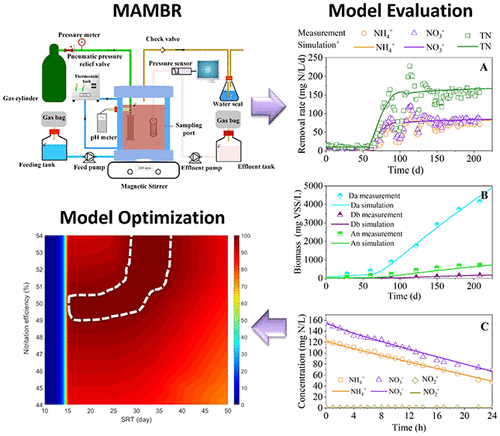当前位置:
X-MOL 学术
›
Environ. Sci. Technol.
›
论文详情
Our official English website, www.x-mol.net, welcomes your
feedback! (Note: you will need to create a separate account there.)
Denitrifying Anaerobic Methane Oxidation and Anammox Process in a Membrane Aerated Membrane Bioreactor: Kinetic Evaluation and Optimization.
Environmental Science & Technology ( IF 10.8 ) Pub Date : 2020-04-29 , DOI: 10.1021/acs.est.0c01154 Lai Peng 1 , Wen-Bo Nie 2 , Jie Ding 2 , Bing-Jie Ni 3 , Yiwen Liu 3 , Hong-Jun Han 2 , Guo-Jun Xie 2
Environmental Science & Technology ( IF 10.8 ) Pub Date : 2020-04-29 , DOI: 10.1021/acs.est.0c01154 Lai Peng 1 , Wen-Bo Nie 2 , Jie Ding 2 , Bing-Jie Ni 3 , Yiwen Liu 3 , Hong-Jun Han 2 , Guo-Jun Xie 2
Affiliation

|
Denitrifying anaerobic methane oxidation (DAMO) coupled to anaerobic ammonium oxidation (anammox) is a promising technology for complete nitrogen removal with economic and environmental benefit. In this work, a model framework integrating DAMO and anammox process was constructed based on suspended-growth systems. The proposed model was calibrated and validated using experimental data from a sequencing batch reactor and a membrane aerated membrane bioreactor (MAMBR). The model managed to describe removal rates of ammonium (NH4+), nitrite (NO2–), and total nitrogen, as well as biomass changes of DAMO archaea, DAMO bacteria, and anaerobic ammonium oxidizing bacteria (AnAOB) in both reactors. The estimated parameter values revealed that DAMO archaea possessed properties of faster growth and higher biomass yield in suspended-growth systems compared to those in attached-growth systems (e.g., biofilm). Model simulation demonstrated that solid retention time (SRT) was effective in washing out DAMO bacteria, but retaining DAMO archaea and AnAOB in the MAMBR. The optimal SRT and nitritation efficiency (the ratio of the NO2– to the sum of NH4+ and NO2– in the MAMBR influent) were simulated so that 99% of total nitrogen was removed to meet the discharge standard. MAMBR further suggested to be operated with SRT between 15 and 30 days so that the optimal nitritation efficiency could be minimized to 49% for cost savings.
中文翻译:

膜曝气膜生物反应器中反硝化厌氧甲烷氧化和厌氧氨氧化过程:动力学评估和优化。
厌氧甲烷氧化(DAMO)与厌氧铵氧化(anammox)结合进行反硝化是一种有前途的技术,可以完全脱氮,具有经济和环境效益。在这项工作中,基于悬浮生长系统构建了一个将DAMO和厌氧氨氧化工艺相集成的模型框架。使用来自测序间歇反应器和膜曝气膜生物反应器(MAMBR)的实验数据对提出的模型进行校准和验证。该模型成功地描述铵的去除速率(NH 4 +),亚硝酸根(NO 2 -),两个反应器中的总氮以及DAMO古细菌,DAMO细菌和厌氧铵氧化细菌(AnAOB)的生物量变化。估计的参数值表明,与附着生长系统(例如生物膜)相比,DAMO古细菌在悬浮生长系统中具有更快的生长和更高的生物量产量的特性。模型仿真表明,固体保留时间(SRT)可以有效清除DAMO细菌,但可以将DAMO古细菌和AnAOB保留在MAMBR中。最佳的SRT和硝化效率(NO 2 –与NH 4 +和NO 2 –的总和之比)对MAMBR进水口中的总氮进行了模拟,以除去99%的总氮以满足排放标准。MAMBR还建议在15到30天之间使用SRT进行操作,以便将最佳硝化效率降低到49%,以节省成本。
更新日期:2020-04-29
中文翻译:

膜曝气膜生物反应器中反硝化厌氧甲烷氧化和厌氧氨氧化过程:动力学评估和优化。
厌氧甲烷氧化(DAMO)与厌氧铵氧化(anammox)结合进行反硝化是一种有前途的技术,可以完全脱氮,具有经济和环境效益。在这项工作中,基于悬浮生长系统构建了一个将DAMO和厌氧氨氧化工艺相集成的模型框架。使用来自测序间歇反应器和膜曝气膜生物反应器(MAMBR)的实验数据对提出的模型进行校准和验证。该模型成功地描述铵的去除速率(NH 4 +),亚硝酸根(NO 2 -),两个反应器中的总氮以及DAMO古细菌,DAMO细菌和厌氧铵氧化细菌(AnAOB)的生物量变化。估计的参数值表明,与附着生长系统(例如生物膜)相比,DAMO古细菌在悬浮生长系统中具有更快的生长和更高的生物量产量的特性。模型仿真表明,固体保留时间(SRT)可以有效清除DAMO细菌,但可以将DAMO古细菌和AnAOB保留在MAMBR中。最佳的SRT和硝化效率(NO 2 –与NH 4 +和NO 2 –的总和之比)对MAMBR进水口中的总氮进行了模拟,以除去99%的总氮以满足排放标准。MAMBR还建议在15到30天之间使用SRT进行操作,以便将最佳硝化效率降低到49%,以节省成本。

































 京公网安备 11010802027423号
京公网安备 11010802027423号